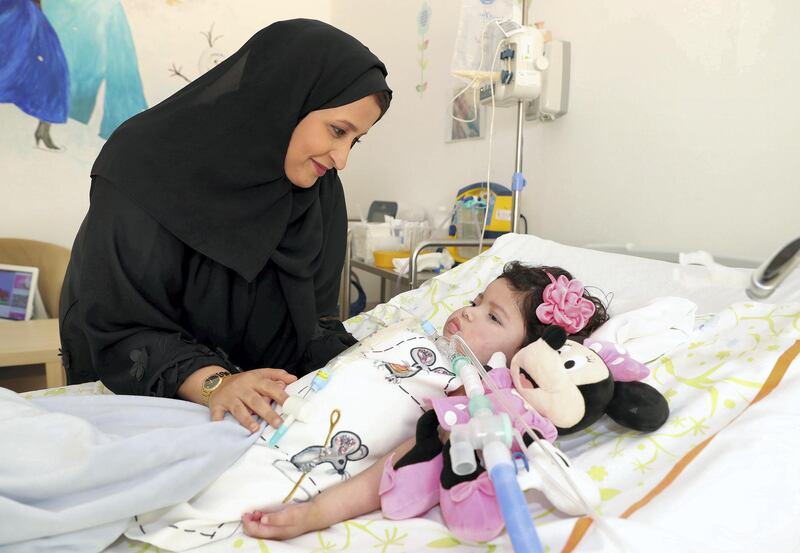Little Osha bin Touq’s smile has been lost to a rare degenerative condition that is affecting about 50 times more babies in the UAE than in the United States.
Spinal Muscular Atrophy is a genetic condition that damages the nervous system controlling voluntary muscle movement.
Doctors diagnosed Osha’s condition days after she was born. She has gradually lost her ability to smile, and now only communicates with her family and full-time carers through eye movements.
A new drug that could halt the progression of symptoms has won US Food and Drug Administration approval, but Spinraza is expensive at about $750,000 (Dh2.75m) for a year-long course.
Specialists are encouraging parents with a family history of SMA to seek genetic screening, to see if they could potentially pass on the condition to children.
“It was the first day of her life,” said Osha’s Emirati mother, Mira bin Touq, who lives in Nad Al Sheba, Dubai.
“We noticed something was wrong but we did not do any test for SMA. We didn’t even know what it was.
“She couldn’t move her head, hands or feet and she wanted to sleep all of the time.
“The nurse noticed she wasn’t moving very much at all. The doctor did a test for SMA, and so it was diagnosed.”
___________________
Read more: Lack of data means more research needed
___________________
The two-year-old has three older brothers, aged 9, 8 and 5, who visit her about three times a week at the specialist Amana Healthcare centre in Khalifa City A in Abu Dhabi. Despite SMA being more common in males than females, and with more serious symptoms, the boys have escaped the condition.
Mrs bin Touq was unaware of a family history of SMA until after Osha’s diagnosis.
“We later discovered that 25 years ago, my sister-in-law had two children with the same condition, and they had already passed away,” she said.
“I knew nothing of SMA up to that point. When I see other patients who are communicating with their families, despite having SMA, it gives me hope that Osha will be able to do the same.”
Osha is one of two children receiving long-term care for SMA at the Amana clinic.
As the condition’s primary effect is on muscles, which don’t receive signals from nerve cells, the children become reliant on ventilators for breathing and specialised intensive care to stabilise their condition.

Dr Carrie Starkie is a general paediatrician with a history of working with patients with complicated health conditions. The doctor, who moved to Abu Dhabi from the US, said inter-marriage can increase the frequency of SMA.
According to the Centre for Arab Genomic Studies, the prevalence of SMA in GCC populations is thought to be at least 50 times higher than in the US, with more than 50 cases per 100,000 live births, compared to only 1.2 in the US.
“Typically, if both parents have the genetic mutation, it can be passed on to children,” said Dr Starkie.
“The UAE is working to build awareness of SMA, to encourage prospective parents to be screened for the condition.
“As the knowledge base increases for genetic screening, so does the potential to shape future healthcare depending on the nuances of the condition to help people make informed choices.
“We do a tremendous amount of the supportive care for the young patients here to help keep their muscles as healthy as possible.”
Nurses at Amana place a huge emphasis on their patient’s quality of life, trying new and innovative ways of opening up communication with family members through eye movement.
Children can be born with five different types of SMA, with varying severity of the illness. Those with SMA 1, the most severe, have a life expectancy of about two years.
Signs of the condition are that babies don’t reach their growth monitors on time, or have control of their heads. Often, they are unable to roll over or sit up.
“These symptoms are similar to other medical conditions, so SMA can take time to diagnose,” Dr Starkie added.
“Parents can be genetically screened to see if they are carriers of the mutation that could be passed on to children.
“Specific testing can identify where parents are in the risk spectrum, and then they can make decisions accordingly.”
Another mother, who did not want to be named, has three children with SMA, aged 8, 9 and 2.
“I have realised the importance of genetic testing before marriage,” she said.
“Couples who are planning to get married may seem healthy, as we thought, but they may be carrying the SMA gene, which increases the possibility of having children born with the disease.”
Abdulrahman was the first-born child for his parents in 2014. His movements started to decrease two weeks after his birth, with limpness in his legs and arms.
"It raised our concerns to see a doctor, and after a week of tests and investigations we were informed that Abdulrahman had SMA," his father said.
"We started to research, to find out more about the causes of this disease and how to treat and prevent it.
“We realised one of the main reasons was inter-family marriage, also a reason of my nephew’s death due to the same disease.”
What is Spinal Muscular Atrophy?
Spinal Muscular Atrophy involves the loss of nerve cells called motor neurons in the spinal cord and is classified as a motor neuron disease.
It is caused by a deficiency of a motor neuron protein called SMN, crucial for normal motor neuron function. Rarer forms of the condition are caused by mutations in other genes.
Symptoms can range from mild to severe. The primary symptom is a weakness of voluntary muscles, with the shoulders, hips, thighs and upper back most affected.
Complications occur when the muscles used for breathing and swallowing are affected.
While in the past infants with SMA typically did not survive more than two years, today most doctors now consider SMN-related SMA to be a continuum and prefer not to make rigid predictions about life expectancy.
“It is usually diagnosed once children become symptomatic,” said Dr Carrie Starkie, a general paediatrician at Amana Healthcare.
“It can be picked up in pre-natal, so siblings who are picked up earlier are more likely to benefit from this new treatment before they are symptomatic.”
In December last year, the US FDA approved a groundbreaking new drug, nusinersen, that could limit the regression of muscle degeneration, if the condition is diagnosed early.
Spinraza, its brand name, is designed to treat the underlying defect in SMA, which means it potentially may be effective at slowing, stopping or perhaps reversing the symptoms.
Although that FDA approval was followed up with a similar endorsement by the European Commission, the costs involved could make the treatment out of reach for some.
Spinraza’s price is set at US$125,000. That is the cost per injection, which adds up to $750,000 for the first year of treatment and $375,000 after that.
Also, eligibility could be restricted to those with less severe symptoms diagnosed through genetic testing, routine blood work, urine tests, cardiac tests and X-rays.
Affected infants who are pre-symptomatic and meet the essential genetic testing criteria will be given the highest priority. Clinical trial data indicates that the younger patients in earlier stages of the disease benefit most from the medication.






